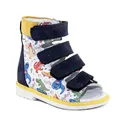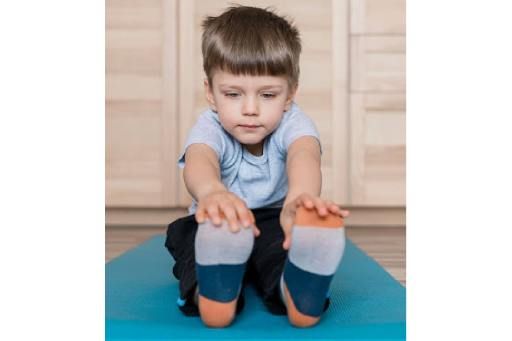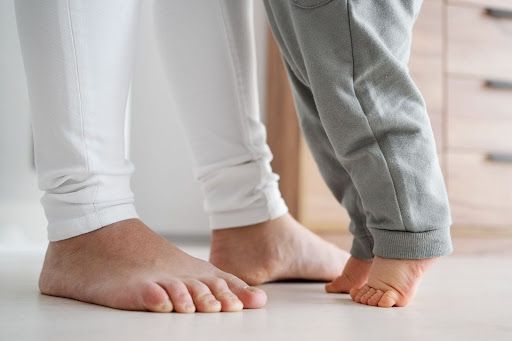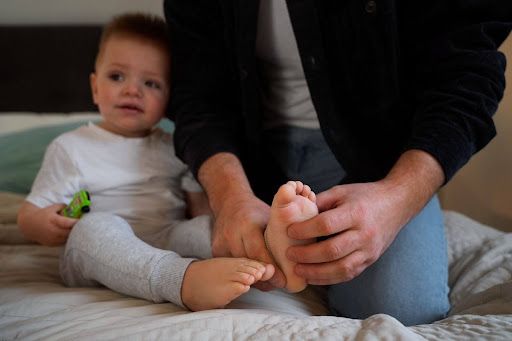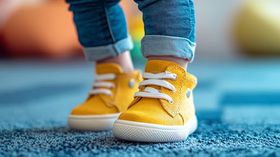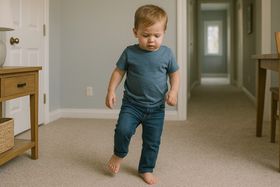Plantar Fasciitis in Children: Causes, Symptoms, and Treatments
Keeping kids active and pain-free: A guide to understanding and managing plantar fasciitis in children
Published January 22, 2025
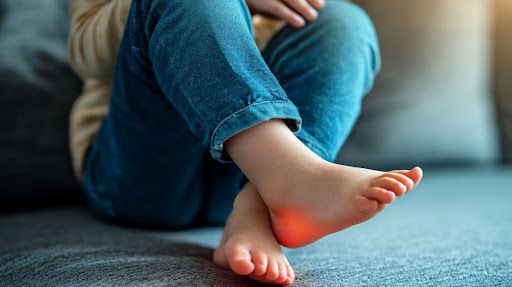
Childhood should be a time of boundless energy—a time for running, jumping, and exploring the world. From their very first steps, children begin to build the foundation for healthy foot development. But, plantar fasciitis can disrupt this joyful period of growth and discovery.
This condition, characterised by heel pain, can transform a child's playful movement into moments of unexpected discomfort and limitation. Unlike adult foot pain, paediatric plantar fasciitis presents a unique set of challenges, intertwined with the complexities of a growing body and the demands of a child's active lifestyle.
Understanding this condition is crucial for parents to effectively support their child's foot health and ensure they can continue to thrive and explore their world with joy and ease.
» Find the perfect shoes to help your kid conquer plantar fasciitis heel pain
What is Plantar Fasciitis?
Plantar fasciitis is a common condition that causes pain in the bottom of the heel. It occurs when the plantar fascia, a thick tissue band connecting the heel bone to the toes, becomes inflamed. [1]
This inflammation can cause sharp, stabbing pain, especially in the morning after the first few steps. Pain may also worsen with activity, such as standing, walking, or running. While often painful, with proper care and attention, most kids can recover fully.
Causes of Plantar Fasciitis in Kids
Plantar fasciitis in children arises from a unique combination of factors related to their growth and development:
- Rapid Growth: During growth spurts, bones, particularly the heel bone, grow faster than the surrounding soft tissues, including the plantar fascia. This mismatch creates tension and strain, increasing the risk of inflammation and micro tears.
- Overuse: Children are often highly active, participating in sports and activities that involve repetitive motions (running, jumping) and high-impact landings. This constant stress on the developing plantar fascia can lead to overuse injuries.
- Inappropriate Footwear: Children's feet are still growing, so correctly fitting shoes with adequate support and cushioning is crucial. Improper footwear can exacerbate stress on the plantar fascia, increasing the risk of injury.
- Biomechanical Issues: Flat feet or high arches are common in children and can significantly disrupt weight distribution, placing excessive stress on the plantar fascia.
- Repetitive Strain: Sports that involve repetitive motions, such as ballet, gymnastics, and certain dance forms, can place significant strain on the plantar fascia, particularly during jumps and landings.
- Obesity: Excess weight increases pressure on the foot, further straining the plantar fascia and increasing the risk of inflammation and micro tears.
» Read our parents' guide to helping your little one to walk
Symptoms of Plantar Fasciitis in Children
Parents should be aware of the following symptoms, which may indicate plantar fasciitis in their child:
- Morning Heel Pain: Children may experience sharp, stabbing pain in the heel, especially in the morning, upon taking their first steps. This is often referred to as "first-step pain."
- Post-Exercise Pain: Heel pain or stiffness may worsen after physical activity, such as running, jumping, or playing sports.
- Localised Tenderness: Tenderness or discomfort may be felt when applying pressure to the bottom of the heel, particularly near the arch.
- Limping: Children may limp or avoid weighting the affected foot due to heel pain.
- Swelling (Occasional): Some children may experience mild swelling in the heel area, although this is not always present.
» Explore kids' shoes for orthotics and support their foot health
Differentiating Plantar Fasciitis from Other Conditions
It's important to distinguish plantar fasciitis from other potential causes of heel pain in children.
- Growing Pains: Unlike the localised heel pain of plantar fasciitis, growing pains typically affect both legs, worsen at night, and are more widespread.
- Injuries: Acute injuries, such as sprains or fractures, often present with immediate pain, swelling, and bruising and may be caused by a traumatic event.
- Sever's Disease: This condition affects the growth plate at the back of the heel bone and is common in active children. It often presents with pain at the back of the heel rather than the bottom.
» Find the perfect shoes to help your child overcome heel pain
How Plantar Fasciitis is Diagnosed
If you suspect your child may have plantar fasciitis, a healthcare professional will likely conduct a thorough evaluation, which may include:
- Physical Examination: A comprehensive assessment includes observing your child's gait, palpating the heel and arch to pinpoint areas of tenderness, and evaluating the range of motion.
- Health History: A detailed medical history will be taken, including information about your little one's activity levels, recent shoe changes, and any history of rapid growth spurts.
- Functional Examinations: Simple tests, such as having your kid stand on their toes or extend their foot dorsally, may be performed to assess range of motion and elicit pain.
- Ultrasound: This non-invasive technique uses sound waves to create images of the soft tissues within the body. Ultrasound can help visualise the plantar fascia and identify areas of inflammation, thickening, or tears.
- X-ray: While primarily used to rule out other conditions like fractures or bone spurs, X-rays can also help identify the presence of heel spurs, which are bony growths that sometimes occur with plantar fasciitis.
If your child experiences persistent heel pain, especially if it significantly impacts their activity levels, consult a paediatrician or a medical specialist for proper diagnosis and treatment.
» See what shoes podiatrists approve for kids
The Valuable Role of Footwear
Perhaps the most essential part of treating plantar fasciitis is footwear. The right shoes can significantly alleviate pain and discomfort by providing the necessary support to reduce stress on the inflamed tissue.
Essential Features to look for in shoes:
- Arch Support: Shoes should have structural arch support to distribute pressure evenly across the foot and reduce strain on the plantar fascia. This is particularly important for children with high arches or flat feet.
- Cushioning: Ample cushioning in the forefoot and heel is crucial to absorbing shock during running or jumping activities. Materials like memory foam and EVA midsoles provide softness and reduce the impact on the heel.
- Firm Heel Counter: A strong heel counter stabilises the heel, minimising excessive motion that can strain the plantar fascia. Please ensure the heel area fits snugly without slipping to maintain proper alignment.
- Flexibility with Support: Shoes should bend at the forefoot while maintaining a strong midfoot, allowing for natural foot movement while preventing over-flexion. This balance reduces strain on the fascia during active play.
- Correct Fit and Breathability: Shoes should be neither too tight nor too loose to promote healthy circulation and minimise pressure points. Materials like leather enhance breathability and comfort, reducing discomfort.
Exercises for Treating Plantar Fasciitis in Children
These exercises can significantly reduce plantar fasciitis symptoms and improve a child's foot health and mobility. Patience and regular practice are essential for successful management.
Stretching Exercises
Stretching is vital in managing plantar fasciitis by increasing flexibility and reducing pain. The following exercises target key muscle groups and help alleviate symptoms:
- Towel Stretch: Ask your kid to sit on the floor with legs extended. Place a towel under their foot and instruct them to gently pull the towel towards them as if trying to touch their toes. Hold this position for about 30 seconds, then repeat.
- Calf Wall Stretch: Position your little one facing a wall with one foot behind the other. Have them lean towards the wall, keeping their back heel firmly on the ground. They should feel a gentle stretch in the back of their leg. Hold this position for 30 seconds, and then switch legs.
- Plantar Fascia Stretch: Have your child sit on the floor and cross one leg over the other. Gently guide their toes back towards their shin. They should feel a stretch on the bottom of their foot. Hold this position for 30 seconds and then repeat with the other leg.
» Explore these exercises to correct toe walking
Strengthening Exercises
Building foot and lower leg muscle strength helps support the plantar fascia and reduce strain:
- Toe Curls: Place a towel on the floor and have your little one use their toes to scrunch and pull the towel toward them. This exercise strengthens the intrinsic foot muscles.
- Heel Raises: Have your kid stand on a flat surface, rise onto their toes, then slowly lower back down. For added difficulty, they can perform this exercise on a step with heels hanging off the edge.
- Marble Pickup: Scatter marbles on the floor and have your child pick them up using only their toes. This exercise improves toe and foot muscle strength.
» Understand how choosing the right footwear helps prevent injuries
Balance and Stability Exercises
Improving overall foot and leg stability can help prevent future plantar fasciitis issues:
- Single-Leg Balance: Have your child stand on one leg for 30 seconds, then switch. Challenge them by closing their eyes or standing on an uneven surface as they improve.
- Arch Lifts: While seated, ask your little one to lift the arch of their foot without curling their toes. This helps strengthen the muscles that support the foot's arch.
» Explore these exercises to correct toe walking
Bonus Tips for Treatment
While proper footwear and exercises are crucial, other treatment options may be considered for plantar fasciitis in children:
- Ice Packs: Applying ice packs to the heel for 15-20 minutes several times daily can help reduce inflammation and pain.
- Over-the-counter Pain Relief: Your doctor might prescribe non-steroidal anti-inflammatory drugs (NSAIDs) to reduce pain and inflammation.
- Massage: Gentle massage of the plantar fascia and surrounding muscles can help improve blood flow, reduce muscle tension, and alleviate pain.
- Night Splints: In some cases, a doctor may recommend night splints. These devices gently hold the foot flexibly during sleep, helping stretch the plantar fascia and reduce morning stiffness.
- Corticosteroid Injections: In severe or persistent cases, corticosteroid injections may be considered. However, these injections are typically used as a last resort and should only be administered by a qualified healthcare professional.
» Follow these tips on how to prevent children's foot injuries
Treatment Timeline for Plantar Fasciitis in Kids
The duration of plantar fasciitis in children can vary significantly, ranging from a few weeks to several months. There are many factors that influence how long it takes for the condition to resolve, including:
- Severity of the condition: Mild cases may resolve within a few weeks with conservative treatment, while more severe cases may require a longer recovery period.
- Child's age and activity level: Younger children may recover faster than older, more active children.
- Adherence to the treatment plan: Consistently sticking to to the recommended treatment plan, including rest, activity modification, exercises, and the use of supportive footwear, is crucial for a faster recovery.
- Underlying causes: Addressing underlying issues such as rapid growth spurts, biomechanical problems (such as flat feet or high arches), or obesity can significantly impact recovery time.
With consistent adherence to the treatment plan, most children experience significant improvement within 3 to 6 months. However, some cases may persist for up to 12 months or longer.
Early intervention is key. Promptly addressing the symptoms and implementing appropriate treatment measures can help minimise the duration of the condition and prevent complication.
» Learn everything there is to know about your child's leg development
From Painful Steps to Playful Leaps
Heel pain can be debilitating, and plantar fasciitis can significantly impact a child's quality of life. Effective treatment requires a multifaceted approach, including rest, activity modification, and appropriate exercises. However, perhaps the most essential element is ensuring appropriate footwear.
First Walkers are specifically designed to prevent and manage plantar fasciitis. Our orthopaedic designs, incorporating features like essential arch support, shock absorption, and a flexible yet stable heel counter, directly address the needs of growing feet.
By mimicking natural foot biomechanics, our shoes distribute pressure evenly, reduce strain on the plantar fascia, and support healthy foot development during crucial early walking stages.
» Try First Walkers to alleviate your child's plantar fasciitis heel pain
Disclaimer: First Walkers' information is intended for educational and informational purposes related to toddler footwear and feet. We encourage you to consider individual circumstances and consult qualified orthopaedists about specific conditions.
References
